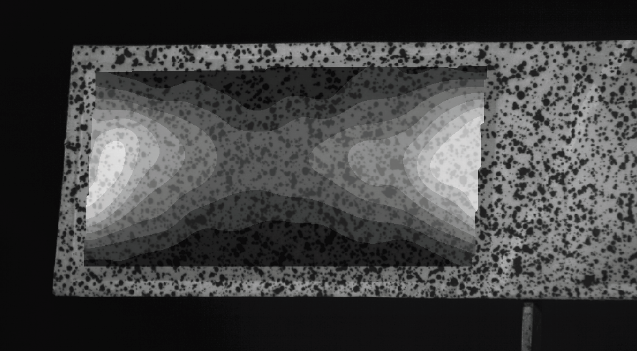Through passive adaptation to incidental flow, flexible aerodynamic surfaces exploit effects of increased lift, delayed stall and disturbance rejection. Wings of birds, bats, and insects exhibit these passive effects, and at the same time through the use of structural state feedback sensed from the loads on the wing, active control is applied to achieve stable and highly dynamic maneuvers. This research predicts aerodynamic loads for flexible wings by sensing their structural responses to static and dynamic airflow conditions.


Correlation of Structural Strain to Tip Vorticity and Lift for a MAV Pliant Membrane Wing
In this work, a flexible membrane wing constructed of latex was considered. The goal of estimating lift was approached through experimental and theoretical correlation of wing strain state due to flow-induced pressure. Using visual image correlation, elastic deformations, strains and membrane pretensions of the wing were measured in the Oregon State University wind tunnel. In addition, a six-degree-of-freedom sting balance was used to determine aerodynamic loads.
A linear membrane wing formulation was utilized to correlate the wing's structural strain to lift and wing-tip vorticity. Results of the forces measured by a sting balance were then compared to those predicted by flow simulation. This work describes experimental results that illustrate the effectiveness of low fidelity models in predicting and estimating useful information for flexible wing designs.
Aerodynamic Load Estimation from Virtual Strain Sensors for a Pliant Membrane Wing
An approach has been developed to utilize the strain sensed in a membrane wing to estimate aerodynamic loads. Through experimental and theoretical correlation of membrane strain state due to a normally distributed load, the pressure over the surface of the wing was estimated. Elastic deformations and strains of the membrane wing were measured in a low-speed wind tunnel using digital image correlation (DIC). Simultaneously, aerodynamic loads were measured using a six component load cell, inclinometer, and pitot tube. DIC displacement measurements were used to form a reduced order model of the membrane displacements via a snapshot proper orthogonal decomposition (POD) method. DIC strain measurements were used to form virtual strain sensors, which served as the sensory input to the estimation. The Poisson equation for a 2D linear-elastic membrane with out-of-plane deformation was used to calculate the normal pressure distribution from virtual strain sensors using POD basis functions and a recursive least squares minimization. Estimated pressure distributions were compared to a high fidelity 3D computational fluid dynamic model and pressures calculated from DIC deformations. Coefficients of lift and pitching moment for steady state flow conditions were estimated, and compared to, measured wind tunnel loads. Results show promise toward the application of a low fidelity estimation approach for real-time load estimation applications.
Modeling Effects of Membrane Tension on Dynamic Stall for a Thin Membrane Wing
An approach for predicting time varying aerodynamic loads on a pitching membrane airfoil due to rotational pitching and steady airflow is presented. Membrane wings display unique aerodynamic characteristics due to their aero-elastic nature, which can provide performance improvements over their rigid airfoil counterpart. Extensive research has been conducted on the dynamics of flexible wings, but limited research exists on practical, computationally inexpensive, predictive models accounting for the dynamic behavior surrounding these wings. The model presented herein, utilizes potential flow theory for a thin cambered airfoil with finite span, combined with a linearized representation of the membrane physics to predict lift under static conditions. Quasi-steady rotational effects from convection lag and added mass effects are considered in a classic potential flow approach, modified for a membrane airfoil. A first order state space representation of the transient flow effects is used to model the dynamic separation delay of the pitching membrane airfoil. Theoretical models and experimental data for rectangular, 2:1 aspect ratio, rigid and flexible airfoils are presented. Comparisons of the static and dynamic lift predictions are made to wind tunnel data, and show favorable accuracy over a wide range of flow conditions.